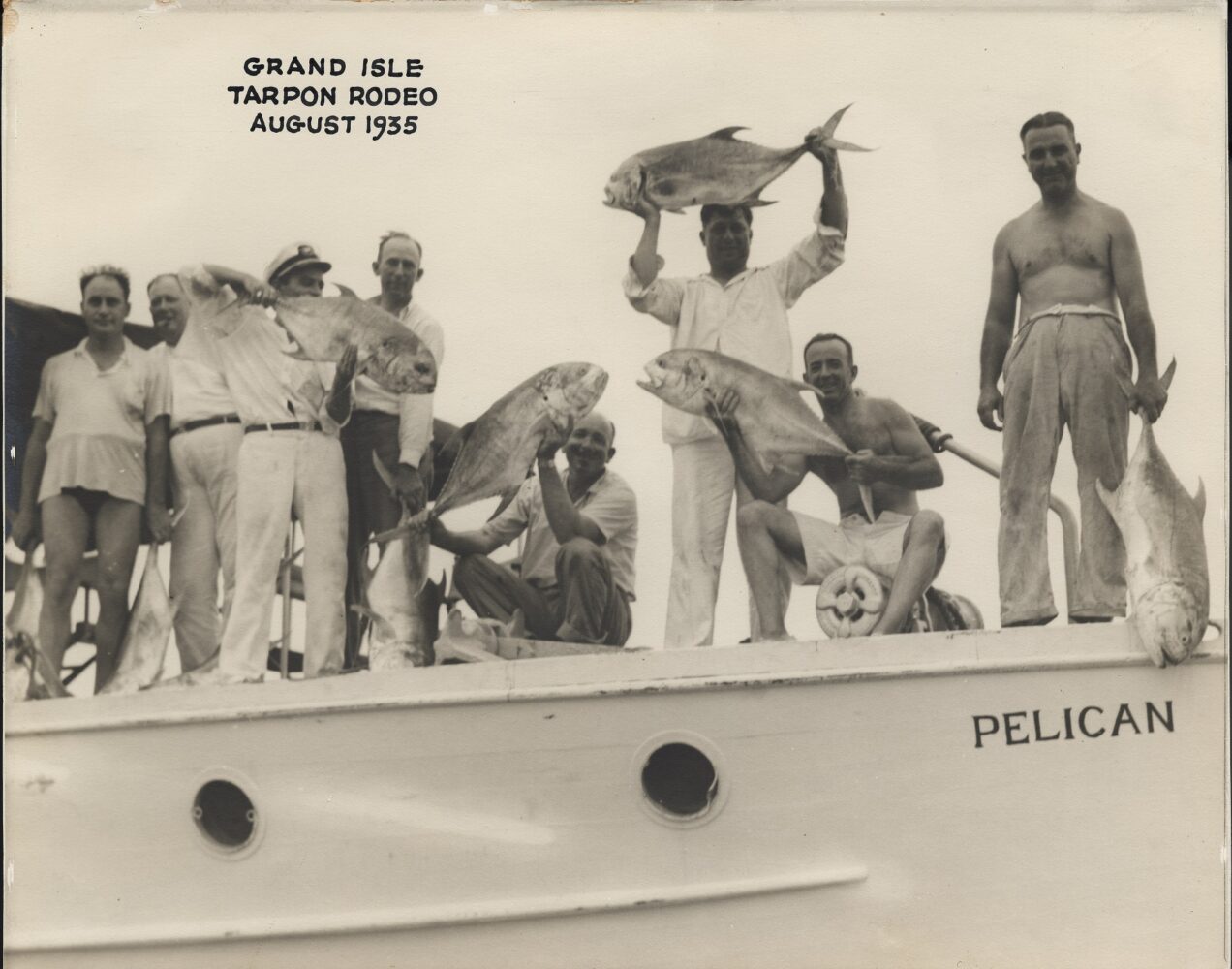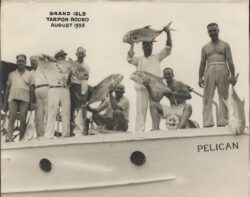Coastal
Not Our First Rodeo
The Grand Isle Tarpon Rodeo is the longest-running fishing tournament in the United States
Published: June 1, 2020
Last Updated: September 1, 2020

Robert S. Maestri Photograph Collection, Louisiana State Museum
Men aboard the Pelican showing off their catch in the Grand Isle Tarpon Rodeo.
Fish camps with names like Therapy, Holy Mackerel, Crab Rehab, and Off the Hook flank both sides of LA 1. The billboards tout businesses with Cajun surnames like LeBlanc and Bergeron. In the dim glow of party lights large groups of friends and family gather around picnic tables beneath houses raised fifteen feet, cooking and eating fresh seafood, drinking beer, and talking into the night. Before dawn, anglers wade into thigh-deep surf to run crab traps and catch speckled trout by rock jetties.
One hundred years ago Grand Isle was a small farming community that supplied vegetables, particularly cucumbers, to the New Orleans French Market. Then, the native island population was a mix of French, Portuguese, Spanish, and Filipino, speaking a unique patois. Influenced by Theodore Roosevelt’s big-game hunting, fishermen excited by the thrill of reeling in a fighting “silver king” made Grand Isle an adventure-seeking sportsman’s destination. When hooked, the platinum fish with mirrored scales acrobatically leaps out of the water, causing a virtual explosion. The tarpon is a one-hundred-thirty-million-year-old migratory species, often weighing more than one hundred pounds, which originally could be found in estuaries, though avid fishermen now travel miles offshore. In 2015 Davis Prevost landed the largest tarpon ever caught in North America, the 246.6-lb. Louisiana State Record Champion out of Grand Isle.
The Grand Isle International Tarpon Rodeo, held the last weekend of July, is America’s oldest fishing tournament, established in 1928 by New Orleanian Hugh M. Wilkinson. Last year more than thirty boats were chartered to search for tarpon at least five miles offshore while as many as five hundred boats fished for other species closer to shore. Multiple prizes were awarded in thirty categories, including catfish, trout, mullet, flounder, croaker, redfish, drum, snapper, mackerel, bonito, bluefish, barracuda, and many others.
In mid-July 2019 a cold front and overabundance of freshwater resulting from Hurricane Barry chased away baitfish, forcing tarpon boats further east. Capt. Lance “Coon Pop” Schouest could not recall another rodeo in forty years without seeing a single tarpon. Mississippi angler Sawyer McMurphy on the Stillwater, owned by Capt. Jeremy McHugh, caught, tagged, and released the only tarpon in the 2019 rodeo. Still, everyone passed a good time.
Not everyone comes to Grand Isle’s Tarpon Rodeo to fish. Rhodus’s father-in-law Weldon Danos met his wife Kayla Toups on the island forty-five years ago, and the couple recently built their own retirement fish camp. “We fish, cook, dance, boil crabs. All the seafood that you could ever want is here.” Danos was installed at Artie’s every evening, enjoying live music from a swamp pop band while a younger clientele gathered upstairs to hear a DJ spin rap.
“A lot of people come to fish; more people come to party. I can’t fish and party anymore. You’ve got to make the choice,” he laughed. In the 1990s the rodeo started attracting large yachts hosting wild parties until other Gulf harbors built marinas with casinos. The annual event has returned to being family-friendly, with a children’s division fishing competition and crab races every afternoon, presided over by the rodeo’s king and queen.
The Tarpon Rodeo Pavilion is the hub of activities. Rockin’ Dopsie Jr. & The Zydeco Twisters drew a big crowd Friday night as the weigh station was closing. On Saturday night, The Wiseguys, “Blues Brothers” impersonators, played before TV weatherman Bob Breck presented awards for Top Fishermen and Women.
Earlier that day, Yum’s Cafe owner Leoda Bladstacker was peeling and deveining fresh shrimp to make quesadillas and salads to serve the lunch crowd. Growing up on Grand Isle she remembers when the general store was the only place to buy goods. “We could go in and buy one slice of cheese or a piece of ham. If the old lady was there, she’d throw in a piece of bread.” Trade vendors would drive through a couple of times a week, selling meat, fruit, pots, and pans. Most families were large, and everyone knew everyone on the island. In 1965 Hurricane Betsy destroyed many of the ramshackle camps. Then the oil fields closed, and many families left for good. Now many of the almost thirteen hundred residents are camp owners from Baton Rouge who’ve built million-dollar homes.
“The island has grown by leaps and bounds since Katrina,” said Bud Dill, former chief deputy of the Lafourche Parish Sheriff’s Office. Dill has been coming to Grand Isle since he was a boy. As a retiree, he plans to spend more time fishing.
Jim Henderson, former New Orleans sportscaster and current rodeo president, has visited the island since the 1970s. He was on the water by 4:30 a.m. daily, fishing for trout and redfish. “I definitely fish. If I didn’t, I wouldn’t be involved,” he remarked.
The LA 1 Bridge and Toll Road, the eight-mile-long and twenty-five-foot-high “Gateway to the Gulf Expressway,” was built over Bayou Lafourche marshes in 2009, making the island more accessible.
Wayne Keller, Executive Director of the Grand Isle Port Commission, has seen land around the island disappearing during his lifetime. “When I would come down here, eight or nine years old, ninety-eight percent of what I saw was green marsh,” he said. “Now, you go stretches of fifteen miles and you think you’re in the Gulf of Mexico,” he told a reporter in 2016. Yet Keller and most of the island’s residents have no plans to leave. “As long as I can hold on, I’m going to hold on.”
Mary Rickard is a freelance writer and environmentalist. A graduate of the University of Illinois School of Journalism, she has contributed numerous human interest and arts and entertainment stories to the Times-Picayune, New Orleans Advocate, and NolaVie as well as theater reviews to Gambit.
 This article was made possible by the BHP-funded project, Coastal Impacts: An Integrated Approach for Community Adaptation, Understanding, and Planning, which will assist local communities to build intergenerational coastal literacy through community conversations around books, film, and exhibitions, fostering greater understanding of and support for coastal restoration projects.
This article was made possible by the BHP-funded project, Coastal Impacts: An Integrated Approach for Community Adaptation, Understanding, and Planning, which will assist local communities to build intergenerational coastal literacy through community conversations around books, film, and exhibitions, fostering greater understanding of and support for coastal restoration projects.
